The PANCE Study Plan They Don’t Teach You in PA School
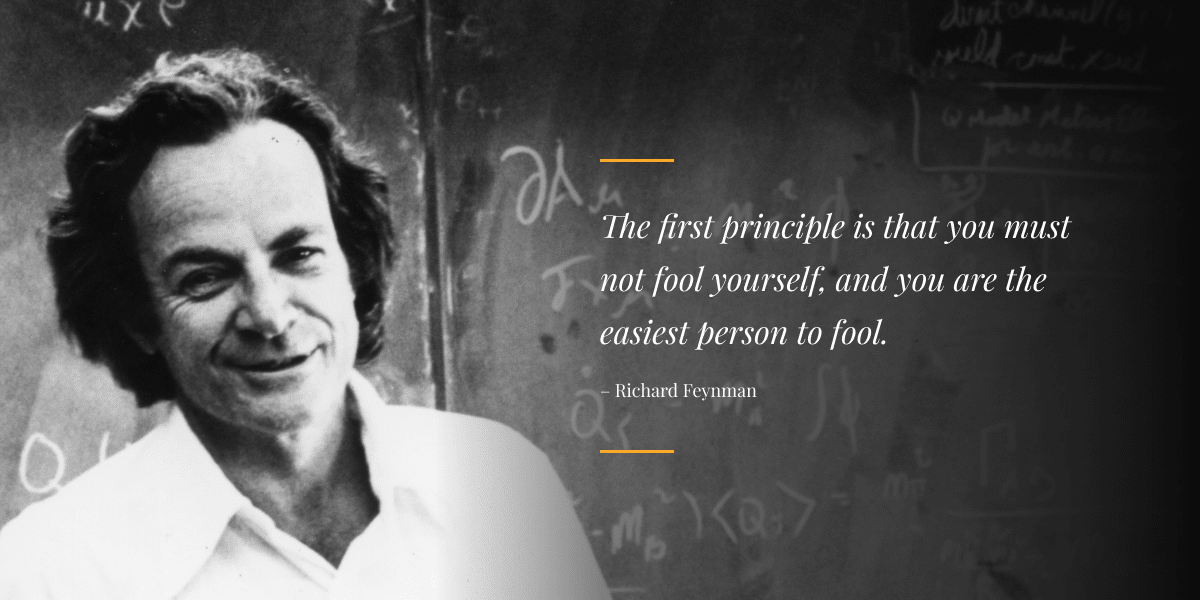
At the end of 2016, a PA student reached out to me after failing her PANCE for the fourth time. The fifth time she took the PANCE, she crushed it and easily passed. These are the techniques we employed for her that you can use for your PANCE review.
Schedule the test so you have plenty of time to build and execute your study plan. My recommendation is 6 months.
Month 1: Visualization and planning
Month 2: Visualization and planning
Month 3: Basal metabolic studying
Month 4: Basal metabolic studying
Month 5: Moderate studying
Month 6: Intense studying
Visualization and planning
Buy a standard marble notebook such as this Meade 0990 Composition Book. Begin doing reconnaissance and record your findings—talk to friends and colleagues who already took the PANCE exam. Find out the resources they used and the strengths of weaknesses of each: Was it easy to use? Did it help to simply review content? Was it accurate? Spend time on chat sites such as PA Forum or other great resource sites such as The Physician Assistant Life.
Get insight into which content will appear on the PANCE. Review the NCCPA content blueprint. Print a copy and keep it near your workspace to reference as you plan your PANCE study schedule. Familiarize yourself with the structure of the exam (5 blocks of 60 questions). Find out when a lunch break is offered. Think about the right day to take your exam. Your schedule should be cleared out at minimum two weeks before exam day (I suggest upwards of four weeks for those who feel they require more concentrated study time). Politely refuse any commitments. Once you schedule your exam date, print out a calendar if you don’t have one already hanging up near your work area. Find your exam date and write in the calendar box in big letters PANCE. Circle it, bold it, color it…whatever you like. Make it prominent and post the calendar in a place that you can see every day. You can add the exam day to your mobile phone, but this is not enough. Have a physical reminder that you can look at every day.
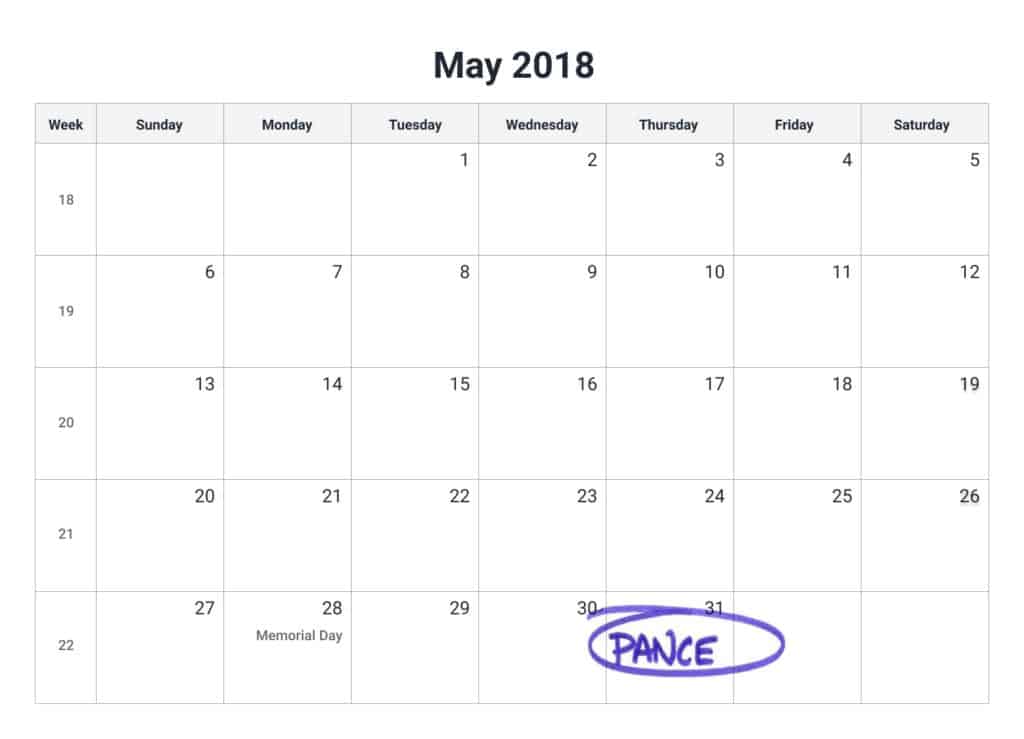
Study space
This is an important component of your plan to figure out. It is obvious you want to pick a place where you are not going to be distracted. Some general suggestions:
- Avoid studying at home if you live with your family. This is not always easy, but preferable.
- Avoid areas that friends can easily make contact with you.
- Avoid areas where people are continually entering and exiting (this causes you to look up often and breaks focus).
We do not rise to the level of our expectations. We fall to the level of our training.
– Archilochus
Simulate Your Testing Environment
The old saying “Practice like you are going to play” can be applied to how you prepare for your PANCE exam. Remember, when you are in front of the computer at the testing center, you do not have access to a cup of coffee, a bag of chocolate, or earphones to listen to your favorite music. It’s you, sitting in a cubicle, and people all around you making disturbing noises, tapping their pen or shaking their leg. You do not control the thermostat, either. Simulating your testing environment and creating artificial stresses while you are studying will help you build focus to avoid distractions that can lead to poor decision making during your exam.
Here are some scenarios that you can put yourself through while in the studying phase:
1. Wear earplugs while you do PANCE practice questions.
Some centers provide you with earplugs and a pair of 1980s headsets. It is important that you practice taking questions with earplugs in your ears. First, they can hurt after a few hours stuffed into your external auditory canal. Second, your thoughts occupy the ambient space and you can paradoxically become distracted by your own thoughts. If you’ve never used earplugs before, it’s like you are underwater. The challenge is to use the silence to focus your mind on answering the questions correctly. My favorite earplugs are the AMAZKER Anti-Noise Earplugs.
2. Spend two days before the exam wearing the same outfit you plan to wear to take the real exam
Since you do not have control of the thermostat like you do in your house or apartment, plan for a warm and cool environment for test day. Pick an outfit that works in both settings. Using layers is always a safe bet. Begin with a lightweight T-shirt as the first layer and add a long sleeve shirt, light sweatshirt, or sweater over it. Wear both to the exam, and if you get too hot, simply take off a layer. During the week before your exam, set aside an hour to work on questions with your thermostat turned up to make it artificially warm and turned down to make it artificially cool. This will allow you to test whether or not the outfit you are wearing is right for both environments.
3. Develop stamina
You are not training to run the 100-meter dash, rather, you are training for the marathon. This means you need to build up endurance. In marathon training, you incrementally increase the number of miles you run leading up to the actual race. Building stamina for your PANCE is similar. The real exam is broken down into five one-hour blocks with short breaks between them. If you do not train properly, you may find yourself fatigued by the third or fourth block, which leads to lazy and sloppy thinking. You want to avoid spending hours and hours preparing for your PANCE only to not perform well on exam day simply because you ran out of steam. The way to build up stamina in test-taking is no different than training for a marathon. Once you are two weeks from exam day, set aside time to take questions without interruption.
14 days before exam day: Take a block of 60 questions and give yourself 1 hour to complete it. Limit your break to 5 minutes before starting the second block of 60 questions. Two blocks of 60 questions (about 2 hours of test taking), is your goal. Slowly introduce your body and brain into long periods of focus.
10 days before exam day: Do the same as above, but now work through 3 blocks of 60 questions for a total work time of 3 hours.
7 days before exam day: Simulate the actual exam. Work through 5 blocks of 60 questions. Limit your breaks to 5 minutes between blocks. Take a 20–30 min lunch after block 3 (eat what you plan to eat on exam day). During this time, you should also replicate actual exam conditions. Wear the same clothes you plan to wear on exam day. Use earplugs. Turn off all notifications on your computer. No food or beverages while you do your questions. Don’t answer the door or phone. Make sure your pet dog has food and water. You want your brain and body to experience as close to the real thing as possible.
3 days before exam day: This is all maintenance. Do 3 blocks of 60 questions.
You can modify any of the variables above. The most important thing is to expose your mind and body to 5 hours of continuous focus. However, just like in marathon training, you need to provide your brain and body a recovery period. I suggest you avoid taking a full-length exam within 24 hours of exam day. Give yourself at least a 24-hour recovery leading up to the exam.
Developing a Routine
Depending on your PANCE study schedule, you may have to make modifications.
7am: Wake up, shower, eat breakfast, etc.
8am – 8:30am: Review notes in notebook from previous days (from day 1 to current day)
8:30am – 10:30am: Study from review book
10:30am – 12:00pm: Qbank/notebook review
12p – 12:30pm: Exercise/walk
12:30pm – 1:00pm: Lunch
1pm – 2pm: Review notes (review book and notebook) from morning session
2pm – 4pm: Study new topic from review book
4pm – 5:30pm: Qbank/notebook review
5:30pm – 7:30pm: Dinner/break
7:30pm – 9:30pm: Review flashcards, notebook, review book (same day material)
9:30pm – 10pm: Prepare for bed
10pm – 11pm: Read 30 minutes to 1 hour of fiction
11pm: Sleep
Let’s take a closer look at each element of the routine.
Morning session (4 hours)
Review Book
My suggestion is to find one good review book that is comprehensive, accurate, and provides material in a manner that is easily digestible. If you feel there is a second book that is stronger in a particular area then also use it, but do your best to limit your core review books to one or two. You can augment the review book with the notes from your classes.
Focus your studying on one chapter at a time. Which chapter depends on how you created your schedule. As you engage in reviewing the material, make it “active,” meaning use techniques such as elaboration. Create mental models in your mind of the topics to better understand them. For example, to learn the effects of hyperthyroidism from thyroid storm, picture thyroid hormone being released from the thyroid gland. The hormone travels in the blood to the heart to cause tachycardia and atrial fibrillation, and it travels to the brain to cause psychosis. Think of it like jet fuel, which revs up the body causing tremors, agitation, and hyperpyrexia.
Now picture your patient with this condition. Picture them on a stretcher in front of you. Now you want to provide treatment. You need to slow down the heart rate and reduce the tremors, so you administer a beta-blocker like propranolol, which also inhibits conversion of T4 to T3. But you need more than just propranolol since the thyroid keeps producing thyroid hormone—you need to stop the production of more thyroid hormone. So you administer propylthiouracil to slow down production. By talking through the pathophysiology, your mind develops a stronger grasp of the material. This is in contrast to simply reading the material and never engaging in it, which often leads to an illusion of knowing. Once the material is taken out of context, you no longer remember it. I bet you can easily recall the picture of a patient with thyroid storm—tachycardic, tremulous, and looking sick.
Below is a page out of a review book that I used to prepare for my board exam.
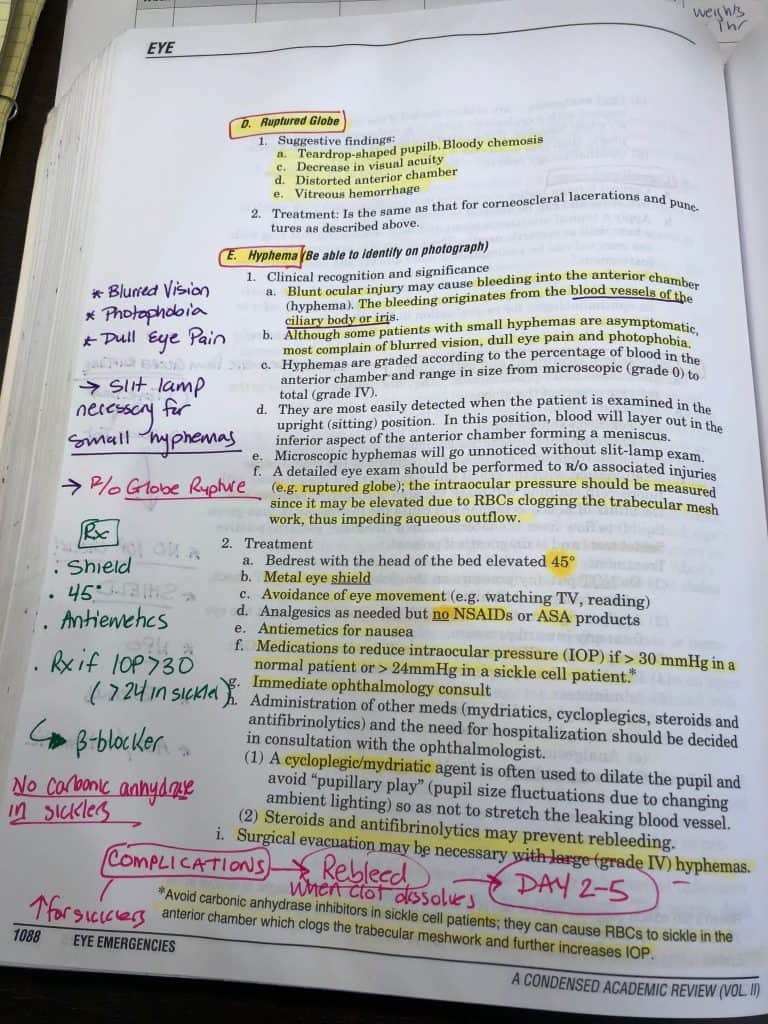
The topics on the page include rupture globe and hyphema. The review book provides a comprehensive review of the topics. While I engaged with the material, I jotted down in the margins notes that I thought were most important to know for the exam. This exposed me to a broad overview of the topics. It was unlikely, however, that I’d remember all of the information. The only way to find out what I retained was to quiz myself using a Qbank and notebook. Using a Qbank is a core component of retrieval practice.
Qbank/notebook review
This is where the magic happens. After reviewing your notebook, do questions in tutor mode (learning mode). Ideally, these questions are similar topics to the topics in the review book. Here is the key behavior…every time you get a question incorrect, write down in your notebook the correct answer and why you got the test question incorrect. Do this for every test question you get incorrect. Also do it for questions you get correct but learn something new when reading the explanation. As you document in your notebook, leave plenty of space for each new concept. Imagine each page of your notebook divided into 2, 3, or 4 sections—each section dedicated to an idea or concept.
The purpose of recording everything you got incorrect and concepts that are new is to identify your unknown unknowns. You use the review book to study areas that you are weak in (your known unknowns), but what about the areas you do not know you are weak in? If you never address these and they show up on the exam, you have little chance of answering correctly. The Qbank/notebook system allows you to go through hundreds (or thousands) of questions and document your unknown unknowns…which eventually you learn. Those unknown unknowns become knowns (along with the known unknowns), which means that when you take your exam, there will be very few areas that you are not familiar with—increasing your chances of answering every question correctly. The Rosh Review Qbank for PANCE is my favorite Qbank (biased, of course), but it was built with these same techniques that helped me pass many standardized exams.
Writing down the incorrect answers is not enough. You need to engage in the content. At the start of each day, begin on page 1 of your notebook and review the material you wrote down. Mark up the pages, underline, bold, rewrite, draw simple diagrams or flow charts. Engage in it. Not only should you do this at the start of each day, but before every time you work on Qbank questions. Then, as you go through the explanations from the Qbank questions in each subsequent session, continue to document the incorrect answers and new concepts. If there is a page in your notebook that already contains content on the topic, instead of creating a new entry, add to the current topic. This is why it is important to leave enough space initially because it is almost certain that you will add more content to each of the topics. By doing this daily for weeks to months, you are essentially creating your own review book. However, this “review book” is built on concepts that were once unfamiliar to you. At the end of your study period, you’ll be so familiar with the concepts in the notebook that there will be very little that you do not know for the exam.
It is important that you review this notebook routine. Review it each morning, before each Qbank session, and whenever possible, at night. Here is an example of the notebook I used to prepare for an exam and a previous blog post about using the notebook system to increase your PANCE score by 100 points.
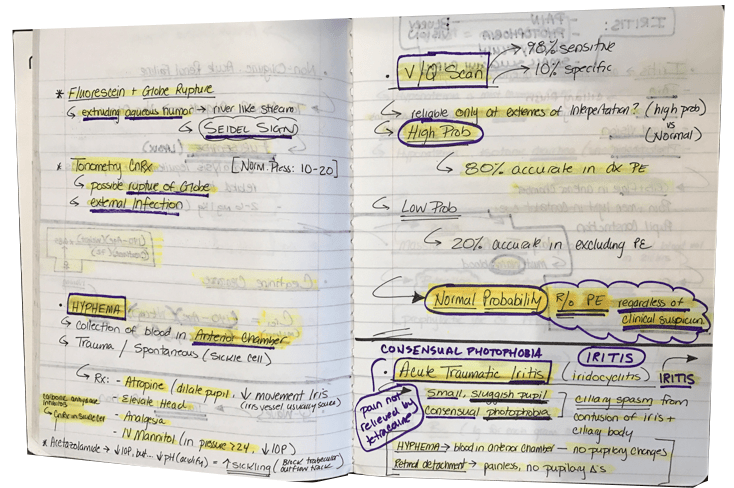
Notice that there are only two (left page includes globe rupture and hyphema and right page includes V/Q scan and acute traumatic iritis) topics on each page. This allowed me space to add new material as I answered more questions in the Qbank.
In case you are wondering what type of notebook to use, my favorite is the standard marble composition notebook that you can pick up for a few dollars. I like these better than spiral-bound notebooks, which often result in pages getting torn or caught in the spiral since there is so much flipping back and forth.
Take a mandatory break for exercise or a walk (30 min)
Allowing yourself a break around midday is more important than you may think. While a break provides the rest you need to maintain long hours of studying, it also serves a much more important role to allow your brain time to process the new information from the morning session and to build connections between this new information and previously reviewed information. It is not uncommon for people to experience clarity or develop greater insight into a topic or process while they are exercising or going for a casual walk. Here are some details to help plan for this 20- to 30-minute midday break. Getting outside is preferential, weather permitting:
- Walk outside
- Go for a jog
- Lift weights
- Ride a bike
- Swim
Avoid using your phone to make or receive calls.
Avoid getting on Facebook or Instagram or sending out Tweets.
This time is meant to let your mind roam. Using social media and being exposed to the dopamine-driven feedback loops of social media will limit the processing ability of your brain and reduce the number of new connections it needs to help make the learning process.
If you have a fitness tracking device, aim to achieve 3,000 steps within 30 minutes.
Lunch (30 min)
Keep this simple. My suggestion is to find a meal or two that you can reproduce day after day. Yes, eat the same thing every day for lunch or switch off with one or two meals. I recommend proteins > carbohydrates, and avoid sugary drinks. The most important thing is to avoid overeating, which almost always leads to the dreaded food coma. Here are some good options:
- Tuna, turkey, chicken, ham, or salami sandwich.
- My favorite tuna is by Wild Planet. It is pricey, but worth it. If you are up to it, I highly recommend a can of Wild Planet sardines daily.
- Salad with grilled chicken and vegetables (can prepare this each Sunday night and add dressing each day).
- Bean salads
- Hard-boiled eggs
During lunch, I suggest reading the newspaper or a book. Yes, still avoid turning to social media. If you need to check your email, limit it to 20 minutes. Another option is to review flashcards or any factoid-based review material (straight forward question and answers).
Afternoon session (4.5 hours)
Now you are ready to begin your afternoon session, which mirrors the morning session. Begin by reviewing the notes you recorded in your review book and the notes you recorded in your notebook that you took from the Qbank. Spend about 30 to 60 min on this. Then begin the next topic or chapter in your review book using the same techniques described for the morning session. Wrap up the afternoon study session by answering questions from the Qbank and recording the questions/answers you got wrong and any new information you acquired.
Dinner and break (2 hours)
This is the longest break in the day. Spend this time to unwind, catch up on personal issues, email, and if you must, check your social media feeds (limit to 15 min). Dinner can be more relaxed. It is not necessary to prepare the same meal every day like I suggest for lunch. Add some variety. Take your time, enjoy the break, prepare a meal from scratch. Grab a bite at a restaurant. Meet a friend out.
Evening session (2 hours)
The final two hours are spent on reinforcement. Go through your flashcards, do a beginning to end review of your notebook, and review the notes you’ve created in the margins of your review book. The goal here is to stay relaxed and work on the highest-yielding review. Essentially, you are consolidating all of the facts and concepts that you’ve learned up to this point. Think of this time as laying the mortar between the bricks.
Pre-sleep routine (30 to 60 min)
One rule, one suggestion.
Rule: No smartphone or mobile device use one hour before going to sleep. Stay out of the minefield. It is so easy to get caught up in scrolling through pictures (I call this the zombie scroll) and watching videos that are going to dilute all of the new information being processed by your brain. While this may hard for you (it certainly was for me), it is the single most important rule to follow when you go to sleep. Instead, I suggest reading 30 minutes of fiction. Some of my recent favorites include The Life of Pi by Yann Martel, How to Get Filthy Rich in Rising Asia by Mohsin Hamid, The Beach by Alex Garland, and What Makes Sammy Run by Budd Schulberg.
Building a Flashcard System
Flashcards are a good way to build fact-based knowledge rather than a deep understanding of material. Nonetheless, flashcards can help you understand the concept better by building relationships. Flashcards are also a good way to capture points on your exam from low-hanging-fruit questions. Occasionally, you come across a question that is identical to one of your flashcards. Eat these up.
Here is an example of a flashcard I created while learning about ECGs.
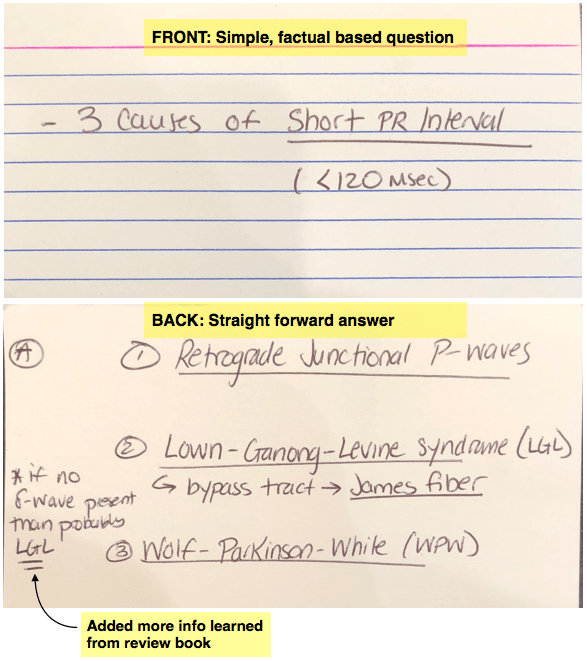
A great utilization of flashcards is to begin these very early in studying, specifically during the basal metabolic phase. One strategy during this phase is to do a preliminary run through your review book and as you are paging through, create flashcards of facts that you do not know. This can be done one or two months leading up to your intense study phase. In fact, you do not even need to review or learn the flashcards during the basal metabolic learning phase—use this time to create the flashcards. You do not want to use your time during intense studying wasted on creating flashcards. This is an ineffective use of time.
It is easy to create long-winded cards—avoid this. Flashcards should be simple, factoid-based learning points. As your studying intensifies, you can add content to a flashcard if it helps to clarify an important point on the flashcard. For example, see the flashcard above. Understand that an ECG with a short PR interval without a delta wave is almost always going to be Lown-Ganong-Levine syndrome.
Using flashcards is an excellent way to learn facts and gain easy points on your exam. There is an optimal way to use your flashcards to boost your retention. Start by doing them consistently, either daily or every other day. After each pass of the cards, set aside the cards you do not know or answered incorrectly. These will be the cards that you begin with for the next flashcard review session. Once you know the answer to a card, not just “kind of,” but it is branded in your mind, set it aside and stop reviewing it daily. You’ll go through these once a week, usually at the end of the week. It is also important to mix the cards you do not know with the cards you do know. Lastly, always give yourself a one- to two-day break after every three days of flashcard review. You want your brain to forget the answers just enough so the next time you review a question you are not sure about, your brain has to work hard to find the answer. This is a type of retrieval practice and spaced repetition, which solidifies neuronal connections and improves retention.
Day 1: All cards, always set aside cards answered correctly
Day 2: All cards, begin with cards answered incorrectly from previous day
Day 3: All cards, begin with cards answered incorrectly from previous day
Day 4: Take off
Day 5: All cards, begin with cards answered incorrectly from previous day
Day 6: All cards, begin with cards answered incorrectly from previous day
Day 7: All cards, begin with cards answered incorrectly from previous day
Day 8: Take off
Day 9: Set aside cards that are “branded” in your mind. Review remaining cards (call this Set #2). Set aside cards answered correctly.
Day 10: Set #2, begin with cards answered incorrectly from previous day
Day 11: Set #2, begin with cards answered incorrectly from previous day
Day 12: Take off
Day 13: Set #2, begin with cards answered incorrectly from previous day
Day 14: Set #2, begin with cards answered incorrectly from previous day
Day 15: Set #2, begin with cards answered incorrectly from previous day
Repeat and add back all cards and start again. After first review, set aside cards “branded” in your mind.
The first principle is that you must not fool yourself, and you are the easiest person to fool.
– Richard Feynman
Be honest with yourself. Capitalize on your strengths and identify weaknesses. If you are most focused in the morning, then use that time to do your most important work. If you get fatigued after lunch, spend this time doing easy/superficial work. If you have a hard time refraining from social media use before bed, leave your phone in another room. There are many different preparation and study techniques available. There is no one best technique. The goal is to find the right one for you.
Your work isn’t done tonight. Your work was done three months ago and you just have to show up.
The night before your exam checklist
- Lay out your clothes
- Pack your lunch
- Use maps service to see how long it is going to take you to get to the testing center. On Google maps, you can get an estimate of your drive time to a location at a specified time of day.
- Locate your car keys or public transportation card. Confirm you have enough gas in your car to get to the exam (enough to get home is optional!).
- Locate your picture ID and pack it with what you are bringing to the testing center
- Plan for an easy, relaxing dinner. Do not overeat. A combination of protein and carbohydrate works well, such as a grilled chicken salad or sushi (nigiri).
- Drink lots of water throughout the day. Restrict the last glass to > 1 hr before bed (you want to avoid nocturia!).
- No alcohol
- If your exam is scheduled for the morning, set your alarm. If you are paranoid like me, set a second alarm for 5 minutes after the first and keep this one walking distance from your bed. If your exam is in the late morning or afternoon, set an alarm for when you need to start getting ready.
- Got to bed to allow yourself an average amount of sleep. If your body is used to 6 hours of sleep, try to sleep 6.5 or 7. Avoid the extremes (9 or 10 hours or 3 or 4 hours). The goal is to keep the same routine from you established over the preceding months. Read your fiction book.
Day of exam
- Eat breakfast.
- Leave your house with enough time to arrive at the testing center (actually in the center, not the parking lot) 30 min before your scheduled exam time (factor in parking time).
- Check in with registration. Place your belongings in your locker.
- You’ll be escorted to your testing station.
- Get comfortable, look around your cubicle, adjust your chair. Adjust clothing layers if necessary.
- Before you begin your exam, take a slow deep breath in and slowly exhale. Do this 5 to 10 times.
- Repeat to yourself that you are ready, you are prepared, and you are going to do this.
- Get it done.
All of the above behaviors and tactics were used by me over the course of two decades of test-taking. They worked for me but they are only suggestions. Everyone has different needs and requirements. It is difficult to put every idea into this blog. For elaboration on specific aspects of this post, please leave a comment. Also, please share techniques that are successful for you.
To conclude, this is the story of Michelle, who after failing her PANCE four times, implemented the above techniques and passed her PANCE.
P.S. Since this post, I created an online course to teach you how to reach your peak performance when taking exams. Take a look at some of the preview lectures and see if it can benefit you. Find out more at Rosh Peak Performance Course.
Disclosure: Includes Amazon Affiliate links to help support free blog content
Get Free Access and Join Thousands of Happy Learners
FAQs
Get a little more clarification
For more information, read Everything You Need to Know for the PANCE Exam and the Top Questions about Qbanks for PA Students, the PANCE, & Rotation Exams.
- How to Boost Your PANCE Score, which teaches you how to determine your "unknown unknowns" and what kinds of grammatical mistakes to look for on the exam
- The Pummel the PANCE series, which includes four articles by PA-Cs detailing their PANCE study plans, favorite resources, and strategies
- The PANCE Study Plan They Don't Teach You in PA School, which covers the tips Adam Rosh gave a PA student who didn't pass the PANCE four times (and she passed after using this strategy!)
- The Rosh Reveal vodcast, where Adam Rosh teaches you the thought process behind answering board exam questions
- Adam Rosh’s interview by Jessica Veale, PA-S, on her podcast The PA Process discussing test-taking strategies, overcoming failure, and building confidence
-
Hi, for the morning study session 830am-1030am, when you would study from the review book, is that old or new content?

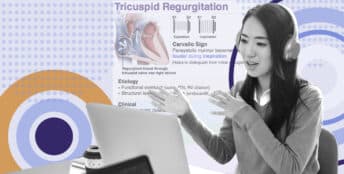



Comments (1)